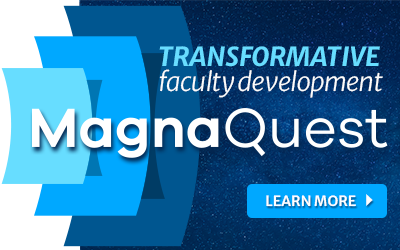This article first appeared in Academic Leader on June 15, 2019. © Magna Publications. All rights reserved.
To help students understand how global “grand challenges” cut across multiple fields, a growing number of colleges and universities are creating courses, faculty clusters, and even entire academic tracks that take a multidisciplinary approach to learning and problem-solving.
Advocates of this trend say it reflects the approach taken at agencies such as the National Institutes of Health, National Science Foundation, and National Academy of Sciences, which are looking to fund more interdisciplinary research. For academic leaders, however, promoting a cross-disciplinary approach to scholarship requires new approaches to hiring and working with faculty.
One example of this trend is the Chancellor’s Faculty Excellence Program at North Carolina State University, which brings together faculty and students from different departments to solve problems through interdisciplinary research. The program addresses issues such as global water, sanitation, and hygiene; sustainable energy systems and policy; and bioinformatics.
In another example, Georgia State University’s Next Generation Program has created clusters of faculty from various departments who work together to solve key challenges. For instance, a Legal Analytics Lab brings together the data analytics expertise of faculty from the Institute for Insight at the Robinson College of Business with the legal expertise of faculty from the College of Law to detect patterns and predict outcomes of legal cases using text mining and machine learning technology. The lab’s work can help law firms and corporate legal departments reduce risk and avoid costly litigation.
“Research generally has become more multidisciplinary as researchers are collaborating to solve larger problems than one discipline can possibly encompass,” says Risa Palm, provost and senior vice president for academic affairs at Georgia State.
“As a result, funding agencies have encouraged larger projects with more cooperating principal investigators. We wanted Georgia State to be well-positioned to participate in this national movement. In addition, we felt that the undergraduate and graduate education of our students would be enhanced if the university developed research around some of the major issues facing society.”
While these research clusters raise the university’s profile and bring in additional revenue, they also benefit students, Palm says: “Undergraduates are involved in research, and we have new interdisciplinary tracks at the BA and MA levels. Examples include a new health technology track, a legal analytics track, and a biology/business track that teaches students how to convert discoveries in the lab to the market.”
Not just for research universities
The trend toward interdisciplinary scholarship isn’t just shaping the work of research universities. At Bryn Mawr College, the 360° program gives students the opportunity to learn within clusters of courses that connect them with faculty across disciplines to focus on common problems, themes, and experiences. The program culminates in a field research component.
A cluster approved for the spring 2020 semester, for instance, will look at climate change from philosophical, scientific, mathematical, and policy perspectives to highlight both the complexity of the issue and the many innovative ideas being developed to address it worldwide. Students will travel to the “green” city of Freiburg, Germany, as well as nearby Philadelphia to look at sustainability initiatives.
“The 360° program was created out of an interest in helping students articulate and specify connections between courses and disciplines,” says Sarah R. Theobald, academic program administrator at Bryn Mawr.
Logistics can be a challenge in coordinating multidisciplinary scholarship. “Bringing together faculty with various leave schedules and teaching approaches can lead to challenges in scheduling the clusters,” Theobald says. “Also, both faculty and students spend more time together in and out of the classroom than they do with a typical course load. It’s become clear to us that expectation setting is important. We require faculty to meet with each other at least twice each month, and there are at least monthly gatherings of the cohort of faculty and students—so being clear about the time we expect participants to devote is vital.”
Faculty are awarded 1.5 credits for teaching a 360° course to account for the additional time it requires, she notes, whereas a typical course is one credit.
Hiring and faculty buy-in
Getting faculty to see the value of multidisciplinary teaching and research is important, leaders say—and letting faculty drive the process helps earn their support. In all three of these examples, faculty groups submit proposals for interdisciplinary clusters that both peers and administrators evaluate for approval.
“The purposeful, bottom-up approach of engaging faculty in the development of proposals and selection of clusters has been critical to buy-in and the success of our effort,” says Duane Larick, senior vice provost for academic strategy and resource management at NC State.
Communicating the benefits of a multidisciplinary approach to scholarship is also essential. “Communicate the benefits early and often,” Palm advises. “A few years into the program, the associate provost in charge of the program and I met with every department to talk about who we had hired and the difference they had made for the university. This series of meetings was very important to convey exactly what the program was about and counter some of the misinformation.”
Implementing a multidisciplinary approach alongside traditional, discipline-focused teaching and research has changed how Georgia State and NC State have approached their hiring practices.
In hiring what the university calls “world-class academic minds” to support its research clusters, NC State has “turned the traditional hiring process around,” Larick says. “Instead of hiring people at the department level and then seeing how those new faculty members could fit into university centers or institutes—the units on campus that have traditionally spearheaded cross-disciplinary efforts—the university first identified gaps in broad research areas and then created clusters and positions to fill in those gaps.”
NC State has also updated its policy for tenure, the system of faculty promotion traditionally granted within individual departments. “Now, faculty members in clusters can be evaluated either by voting faculty in their home department—the traditional method—or by an interdisciplinary review committee,” he says.
Georgia State has two hiring tracks. “One is controlled by the deans and departments and is based on vacancies or enrollment needs,” Palm says. “The other is based on the awards from the provost’s office under the Next Generation Program and involves multidisciplinary clusters of faculty.”
Some faculty might find it hard to collaborate beyond disciplinary boundaries “because of their training in graduate school or their departmental acculturation as junior faculty members,” she observes. “But we are making changes in our promotion and tenure system as well as regular faculty evaluations to take multidisciplinary work into account.”
While multidisciplinary scholarship isn’t intended to replace traditional approaches to teaching and research, “it absolutely is becoming increasingly important in academic scholarship,” she concludes.
Dennis Pierce is a freelance writer who has been reporting on education for more than two decades.



